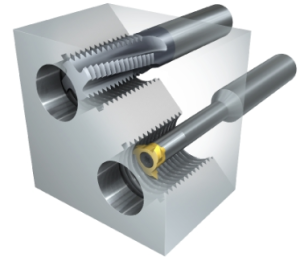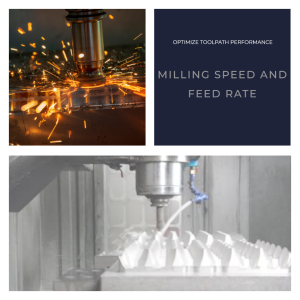Chapter 2: Thread Mill Selection
Choosing the optimal thread mill is critical for achieving desired thread quality, accuracy and tool life. This chapter will examine the key factors impacting thread mill selection including intended application, tool style, diameter and reach, flute count, and substrate/coating combinations. A systematic selection approach helps match the thread mill to the application.
Important Tread Mill Factors to Consider
Thread mill selection is based on multiple variables related to the machining application and desired results:
- Thread specifications – Required thread form, size, pitch, tolerance, etc dictate tool geometry.
- Hole specifications – Depth, blind or through, straight or tapered impact tool length and style.
- Workpiece material – Material type and hardness determine ideal substrate and coating.
- Operation type – Thread milling, helical interpolation or spiral wrapping influence choice.
- Machine power – Available machine torque and RPM range constrain tool size selection.
- Rigidity – Set up stiffness limits length-to-diameter ratio for required stability.
Determining the thread size and type along with the workpiece qualities and operation boundaries provides selection criteria.
Choosing the Right Style
The thread mill style impacts suitability for different hole types and depths:
Tapered Thread Mills
Taper tools excel in blind hole applications where clearance is needed. The reduced neck diameter provides access and allows engaging the thread deeper into the hole.
Taper length should be matched to hole depth so cutting section reaches full depth. Avoid forcing a tapered tool deep enough that the neck contacts the bore bottom.
Straight Shank Thread Mills
Straight tools with uniform diameter are ideal for through holes or large blind holes with adequate entry clearance. They provide continuous stability and chip room.
Variable Helix Thread Mills
Variable helix flutes help eject chips in difficult materials. This style improves chip removal in blind holes or deficient lubrication setups.
Variable Profile Thread Mills
These specialized tools excel in flexing materials like aluminum that may spring back. The changing profile along the length compensates for potential variations.
Duplex Thread Mills
Duplex tools work well in deeper holes where evacuating chips is challenging. The discontinuous flutes provide additional space for debris extraction.
Indexable Thread Mills
Indexable tools allow switching to fresh inserts once cutting edges are worn. They provide economy in high volume threading. Select indexable tools where frequent tool changes are expected.
Diameter, Length and Reach
Proper tool proportions including reach/length ratios are critical for sufficient stability, access and optimal application:
- Diameter should be 1.25-1.5x thread major diameter for clearance.
- Length is determined by hole depth plus a small allowance (~0.5mm)
- Reach should allow accessing hole bottom comfortably.
- Reach ratio to neck diameter should not exceed 5:1 for rigidity.
- Never use less than 3-4 pitches of cutting length.
Inadequate reach or overhang decreases stability. Excess reach invites potential deflection and chatter. Optimizing dimensions suit the operation.
Number of Flutes
More flutes enable higher feed rates but reduce space for chip evacuation:
- 2-3 flutes for softer low carbon steels requiring maximum chip room and lubrication.
- 3-4 flutes for most common steels, aluminums and harder non-ferrous alloys.
- 5+ flutes for hardest alloys like titanium and Inconel where rigidity for shearing is critical.
Higher flute counts increase stability but reduce space between flutes for chip ejection. The workpiece material guides ideal flute number.
Material and Coatings
The substrate and coating combination ensures good performance across expected workpiece hardness ranges:
Soft Steels – Coarse carbide (P10-P20) with TiN. More cobalt for toughness without sacrificing lubricity.
Common Steels – Fine carbide grains (P40-P50) with AlTiN/TiAlN coating handles most steel alloys.
Hardened Steels – Sub-micron carbide with ZrN coating provides hardness for abrasive materials and interrupted cuts.
Exotic Alloys – Ultra-fine carbide and AlTiN coating for strength and heat resistance at higher speeds.
Aluminum/Gummy Materials – Coarse carbide with diamond coating for reduced galling and friction.
Matching tool construction to workpiece characteristics ensures good finish and predictable tool life across diverse materials.
Review Requirements for Optimized Selection
Cross-referencing all operation parameters guides optimal thread mill selection for the application:
- Thread specifications – form, size, pitch
- Hole specifications – depth, diameter, straight/tapered
- Workpiece material – type, hardness
- Operation – threading, wrapping, etc
- Machine torque and RPM range
- Setup rigidity
- Chip evacuation needs
With these considerations defined, you can narrow down your options to the thread mill style, dimensions, flute count and tool construction that aligns with the application demands. An application-focused selection process results in ideal performance and productivity.
Carefully evaluating the operating conditions and choosing tools accordingly provides a recipe for threading success across a wide range of parts and materials. Always double check that selections fall within machine capabilities to avoid equipment overload or imbalance. With the right thread mill matched to your specific machining needs, efficient and consistent thread production is achievable.



